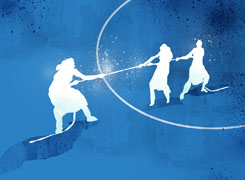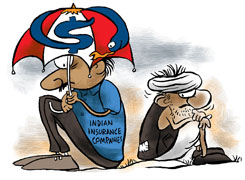Ramalingam Kalirajan |8459 Answers |Ask -Follow
Mutual Funds, Financial Planning Expert - Answered on Jul 11, 2024
He has an MBA in finance from the University of Madras and is a certified financial planner.
He is the director and chief financial planner at Holistic Investment, a Chennai-based firm that offers financial planning and wealth management advice.... more

Hi. I am 44 years old and my wife is 43. Me and my wife both are teachers by profession. My salary is 50k and and my wife 40k. I give extra coaching to students to earn more. At present my family assets are- I have 9 lakhs in EPF, 17 lakhs in PPF in 13 years (will invest 17 more years), My wife also possess 6 lakhs in PPF in 5 years (will invest 17 more years), I have 20 lakhs in Pension Plan with 10 years deferment period, 33 laks in FD, 10 lakhs in KVP, 15 lakhs and 4 lakhs in PMVVY, 15 lakhs in SCSS, 7 lakhs in LIC Jeevan Akshay Plan, LIC insurance plan of 15000 Annually, Health Insurance of 10 lacs and extra top up for family, 5000 in NPS/ PM, investment in APY, SIP of 16000/ PM, My wife invests 7000 in NPS/ PM. I have a multi stored apartment to live, a scooty and a bike and a car. I have 16 years left and my wife has 17 left to be 60 years. Plz suggest can we both safely retire at 60 with all these assets. Also keep in mind our future investments in the period left. Rupam Roy Tripura
Thank you for sharing such detailed information about your financial status. I understand the importance of planning for a secure retirement. Based on the information you provided, let's dive into an in-depth analysis and assessment of your financial situation. I aim to ensure you and your wife can safely retire at 60 with peace of mind.
Current Financial Overview
You and your wife are both teachers, earning Rs 50,000 and Rs 40,000 respectively. Additionally, you earn extra income through coaching. You have a multi-storied apartment to live in, a scooty, a bike, and a car. Your family assets are as follows:
EPF: Rs 9 lakhs
PPF: Rs 17 lakhs (13 years invested, 17 years remaining)
Wife's PPF: Rs 6 lakhs (5 years invested, 17 years remaining)
Pension Plan: Rs 20 lakhs (10 years deferment)
Fixed Deposits: Rs 33 lakhs
KVP: Rs 10 lakhs
PMVVY: Rs 15 lakhs and Rs 4 lakhs
SCSS: Rs 15 lakhs
LIC Jeevan Akshay Plan: Rs 7 lakhs
LIC Insurance Plan: Rs 15,000 annually
Health Insurance: Rs 10 lakhs with a family top-up
NPS: Rs 5,000 monthly
Wife's NPS: Rs 7,000 monthly
SIP: Rs 16,000 monthly
Retirement Goals and Planning
Compliments and Empathy
First of all, congratulations on having a well-diversified portfolio. It's evident that you have made thoughtful investments to secure your family's future. Planning for retirement can be daunting, but with your disciplined savings and investments, you are on the right path.
Assessment of Current Investments
Provident Funds (EPF and PPF)
Your combined PPF investments (Rs 17 lakhs and Rs 6 lakhs) will continue to grow over the next 17 years. PPF is a reliable and safe investment with tax benefits, making it a strong pillar of your retirement corpus.
Pension Plan
The Rs 20 lakhs in your pension plan with a 10-year deferment period will provide a steady income stream during retirement. This plan is beneficial for financial security post-retirement.
Fixed Deposits (FDs) and KVP
Your FDs worth Rs 33 lakhs and KVP worth Rs 10 lakhs offer safety but may not beat inflation. Diversifying into higher-yielding instruments while maintaining some in these secure options is advisable.
Senior Citizen Savings Scheme (SCSS) and PMVVY
SCSS and PMVVY are excellent choices for steady post-retirement income, given their safety and regular payouts. These are good investments for your retirement phase.
LIC Jeevan Akshay Plan and LIC Insurance
While the LIC Jeevan Akshay Plan provides immediate annuity, it's essential to evaluate its returns against other options. The LIC insurance plan's Rs 15,000 annual premium is a sound investment for life coverage.
Health Insurance
Having Rs 10 lakhs in health insurance with a top-up is commendable. It ensures your medical expenses are covered, providing peace of mind.
National Pension System (NPS)
Your monthly contributions to NPS (Rs 5,000) and your wife's (Rs 7,000) are excellent for building a substantial retirement corpus. NPS offers tax benefits and market-linked growth.
Systematic Investment Plan (SIP)
A monthly SIP of Rs 16,000 is a great way to invest in mutual funds, which offer the potential for higher returns through equity exposure.
Future Investments and Strategy
Evaluating Mutual Funds
Categories of Mutual Funds
Mutual funds come in various categories: equity, debt, hybrid, and more. Each serves different investment goals and risk appetites.
Equity Mutual Funds: Invest in stocks, offering high returns but with higher risk.
Debt Mutual Funds: Invest in bonds, providing stable returns with lower risk.
Hybrid Funds: Combine equity and debt for balanced returns and risk.
Power of Compounding
Mutual funds benefit from the power of compounding, where your returns generate further returns over time. This can significantly grow your corpus over 17 years.
Advantages and Risks
Mutual funds offer diversification, professional management, and liquidity. However, they carry market risk, and it's essential to choose funds based on your risk tolerance and goals.
SIP Strategy
Continue your Rs 16,000 monthly SIPs. SIPs help in rupee cost averaging and mitigate market volatility. Consider investing in a mix of large-cap, mid-cap, and hybrid funds for diversification.
Additional Investments
Enhancing NPS Contributions
Increasing your NPS contributions can further boost your retirement corpus. NPS offers flexibility in asset allocation and the potential for higher returns.
Reviewing Insurance
Evaluate your LIC Jeevan Akshay Plan and other policies. If returns are lower compared to mutual funds, consider surrendering and reinvesting in mutual funds. Consult a Certified Financial Planner for personalized advice.
Emergency Fund
Maintain a sufficient emergency fund in a liquid instrument like a high-interest savings account or a liquid mutual fund. This ensures you can handle unexpected expenses without disrupting your investment strategy.
Diversification and Risk Management
Asset Allocation
Maintain a balanced asset allocation between equity, debt, and other instruments. This reduces risk and ensures steady growth.
Regular Reviews
Review your portfolio annually with a Certified Financial Planner. Adjust based on life changes, market conditions, and financial goals.
Final Insights
You and your wife have made commendable progress towards securing your financial future. With disciplined investments, continued savings, and strategic adjustments, you can achieve a comfortable retirement at 60. Focus on diversification, regular reviews, and leveraging mutual funds for higher growth potential.
Best Regards,
K. Ramalingam, MBA, CFP
Chief Financial Planner
www.holisticinvestment.in
You may like to see similar questions and answers below
Ramalingam Kalirajan |8459 Answers |Ask -Follow
Mutual Funds, Financial Planning Expert - Answered on May 31, 2024
Milind Vadjikar |1236 Answers |Ask -Follow
Insurance, Stocks, MF, PF Expert - Answered on Nov 03, 2024
Ramalingam Kalirajan |8459 Answers |Ask -Follow
Mutual Funds, Financial Planning Expert - Answered on Dec 31, 2024
Dr Nagarajan J S K |406 Answers |Ask -Follow
NEET, Medical, Pharmacy Careers - Answered on May 16, 2025

Based on my understanding, no one usually requests a birth certificate at this age. Your inquiry relates to the period before and after independence. In those days, they would accept the SSLC book if you didn't have a birth certificate. However, I am not sure if that was the case during your time.
Instead, you can present your Aadhaar card, which likely includes your original date of birth. You can utilize that information.
If my response doesn't fully address your concerns, I recommend consulting a Notary Public for further assistance.
BEST WISHES.
THANK YOU SIR.
with regards
Prof Suvasish Mukhopadhyay |651 Answers |Ask -Follow
Career Counsellor - Answered on May 16, 2025
Prof Suvasish Mukhopadhyay |651 Answers |Ask -Follow
Career Counsellor - Answered on May 16, 2025
Radheshyam Zanwar |1634 Answers |Ask -Follow
MHT-CET, IIT-JEE, NEET-UG Expert - Answered on May 16, 2025
Radheshyam Zanwar |1634 Answers |Ask -Follow
MHT-CET, IIT-JEE, NEET-UG Expert - Answered on May 16, 2025
Ashwini Dasgupta |107 Answers |Ask -Follow
Personality Development Expert, Career Coach - Answered on May 16, 2025
Ramalingam Kalirajan |8459 Answers |Ask -Follow
Mutual Funds, Financial Planning Expert - Answered on May 16, 2025
Ramalingam Kalirajan |8459 Answers |Ask -Follow
Mutual Funds, Financial Planning Expert - Answered on May 16, 2025
Milind Vadjikar |1236 Answers |Ask -Follow
Insurance, Stocks, MF, PF Expert - Answered on May 16, 2025
Milind Vadjikar |1236 Answers |Ask -Follow
Insurance, Stocks, MF, PF Expert - Answered on May 16, 2025
























